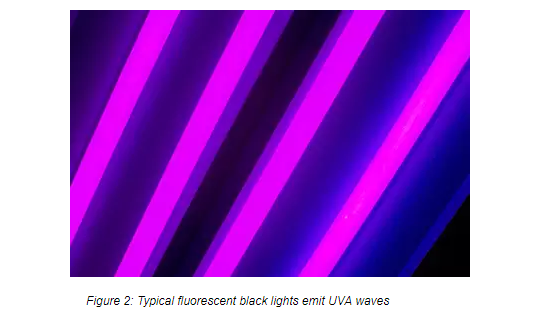
A brief history
German physicist Johann Wilhelm Ritter discover UV radiation in 1801. He observed an accelerated darkening of silver-chloride soaked paper when it was exposed to invisible rays just beyond the visible spectrum on the violet end. To distinguish these rays from the “heat rays” (IR) discovered the previous year on the other end of the visible spectrum, he called the UV radiation “oxidizing rays” which emphasized the chemical reactivity he observed. This was quickly replaced by the term “chemical rays” which remained popular throughout the rest of the 19th century. Eventually, the chemical and heat ray terms were replaced with the now common ultraviolet and infrared designations, respectively.
What is UV?
In the electromagnetic spectrum, ultraviolet (UV) radiation is classified as having a wavelength from 10 nm to 400 nm. These wavelengths are shorter than those of visible light and longer than those of X-rays. There are three classifications of UV light: UVA has wavelengths between 315 and 400 nm, UVB has wavelengths between 280 and 315 nm, and UVC has wavelengths between 100 and 280 nm.
 Our sun emits UV radiation across the 10 to 400 nm spectrum. At the edge of Earth’s atmosphere sunlight consists of approximately 50% infrared (IR), 40% visible, and 10% UV light. By the time it reaches the Earth’s surface, with the sun at its highest point, the composition of the sunlight is 53% IR, 44% visible, and 3% UV. Of this 3% of UV that reaches the ground, approximately 95% is UVA and 5% is UVB. Of course, these percentages vary somewhat with cloud cover and other atmospheric conditions.
Our sun emits UV radiation across the 10 to 400 nm spectrum. At the edge of Earth’s atmosphere sunlight consists of approximately 50% infrared (IR), 40% visible, and 10% UV light. By the time it reaches the Earth’s surface, with the sun at its highest point, the composition of the sunlight is 53% IR, 44% visible, and 3% UV. Of this 3% of UV that reaches the ground, approximately 95% is UVA and 5% is UVB. Of course, these percentages vary somewhat with cloud cover and other atmospheric conditions.
Much of the UVC wavelengths are absorbed by oxygen in the upper atmosphere which then generates ozone in the ozone layer. The ozone layer blocks most of the UVB and the remainder of the UVC not already absorbed by oxygen.
Artificial UV Emitters
The sun is not the only source of UV radiation. There are several manmade devices that also generate these waves.
Black lights
The UV generators most familiar to people are black lights (Figure 2). Typical black light lamps emit UVA waves with very little visible light. For example, fluorescent black lights use a phosphor coating on the inside of the glass tube to emit UVA waves instead of visible light. More powerful mercury-vapor black lights use the same principle to emit UVA radiation on a larger scale, primarily for concert and theatrical displays.
 The principal applications for black lights are those where extraneous visible light is undesirable while observing the resulting fluorescence caused when certain substances are exposed to UV light.
The principal applications for black lights are those where extraneous visible light is undesirable while observing the resulting fluorescence caused when certain substances are exposed to UV light.
Shortwave UV lamps
Shortwave UV lamps consist of fluorescent lamp tubes without a phosphor coating. UV light with peaks at 253.7 nm and 185 nm, both in the UVC band, are emitted primarily due to the mercury in the tube. However, only the 253.7 nm radiation passes through the fused quartz glass tube while the 185 nm wavelength is completely blocked. The typical efficiency of these lamps is 30% to 40% and they two to three time the UVC power of conventional fluorescent lamps.
The primary application of these lamps is disinfection of laboratory surfaces, food-processing surfaces, and water supplies.
UV Gas-Discharge Lamps
Gas-discharge lamps contain different gases chosen to produce UV radiation at specific spectral lines are used in specialized scientific applications. The main use of these lamps is in UV spectroscopy equipment used in chemical analysis.
Lasers
Lasers can be specifically manufactured to produce UV light. Depending on the laser technology (gas lasers, laser diodes, or solid-state lasers) and the materials used, lasers can be made to cover the entire UV band.
There are many applications for UV lasers including laser engraving, dermatology, keratectomy, chemistry, communications, optical storage, and integrated circuit manufacturing.
Light Emitting Diodes
Light emitting diodes (LEDs) are being manufactured specifically to produce UV light. These devices are currently being used in UV curing applications, sterilization, skin therapy, and in chemistry to identify components mixtures.
Health issues
UV radiation has an impact on human health, both beneficial and harmful. Too much exposure can be harmful while moderate exposure has beneficial effects.
Harmful Effects
Excessive UV radiation exposure has the potential to cause harmful effects to the eye, skin, and immune system.
UVA radiation causes little or no immediate reaction, but at wavelengths near the start of the UVB band (315 nm), photokeratitis (a painful eye condition) and skin redness (lighter skin is more sensitive) start to occur with rapidly increasing damage as wavelengths approach 300 nm. UV in the range of 265 nm to 275 nm, in the UVC band, is the most damaging to the eyes and skin.
UVB overexposure can not only cause sunburn, but is also responsible for some forms of skin cancer.
Beneficial effects
As bad as overexposure to UV can be, there are health benefits to be had if one can moderate their UV exposure. The three primary health benefits of UV exposure are the production of vitamin D, improvement in mood, and increased energy.
Vitamin D
Moderate exposure to UV radiation is a good source of vitamin D. This vitamin aids in the regulation of calcium metabolism, insulin secretion, blood pressure, immunity, and cell propagation. Higher levels of vitamin D have been correlated to lower rates of heart disease, stroke, and diabetes along with a tendency towards lower blood pressure. You can review here the best Vitamin D Supplements from the most trusted brands & health experts that offer you the reliable information on your health.
Skin conditions
There are certain skin conditions that can be treated with UV radiation. With modern phototherapy, successful treatment of eczema, dermatitis, rickets, atopic and localized scleroderma, jaundice, psoriasis, and vitiligo is now possible.
Cardiovascular and hypertension
In patients with high blood pressure and a vitamin D deficiency, it has been shown that UVB exposure can lower their blood pressure. Other medical trials and studies have shown that UV radiation, independent of vitamin D, has measurable health benefits.
Serotonin
The creation of serotonin is promoted by vitamin D and its production is directly proportional to the body’s exposure to UV radiation. Serotonin level changes affect mood and behavior. Its exact effect on the human body is not entirely know, but it is thought that serotonin provides sensations of well-being, serenity, and happiness.
Melanin
Moderate UV exposure increases the amount of melanin, the brown pigment, in the skin (otherwise known as a suntan). Melanin absorbs both UVA and UVB radiation, dissipating it as heat. This protects the skin from both direct and indirect DNA damage.
Applications
There are several applications that harness the properties of UV radiation and provide many benefits to the health and well-being of people. The ability of UV waves to kill microbes and remove contaminants is the primary use today.
Air purification
Indoor environmental contaminants are pretty much organic carbon-based compounds that break down with exposure to high-intensity UVC in the range of 240 nm to 280 nm. It can also destroy the DNA in microorganisms. Therefore, cycling air passed a UVC emitter, such as the RayVioRVXE-280 and RVXP-280 UV LEDs, can aid in the purification of air within the room it is placed. These 280 nm (nominal) UVC LEDs are available as either Star Board units or surface mount devices with typical radiant outputs of 4 mW (RVXE devices), 16 mW (RVXP1 devices), and 50 mW (RVXP4 devices) – suitable for many different applications including air purification.

Sterilization and disinfection
UVC LEDs can also be used for a variety of sterilization and disinfection applications. In medical and biology labs, UVC radiation is used, in conjunction with other techniques, to sterilize tools and workspace surfaces.
Other common applications for UVC radiation include treatment of wastewater and municipal drinking water along. It is even used by spring water bottlers to sterilize their product. Additionally, UVC radiation is being used to kill microorganisms in the food processing industry. For example, fruit juices can be pasteurized by UVC as it flows passed a source.
Therapy
UV radiation is not only useful for purification and sterilization, it is also a skin treatment aid for conditions such as psoriasis and vitiligo (a condition where skin patches lose pigment). In this case, it’s not UVC but UVB waves that are useful. Here again RayVio has LEDs ideal for this application. Their 310 nm LED parts (coming soon to Digi-Key) can be the basis upon which skin therapy devices are designed. These devices are available in the same mounting and radiant output options as the UVC LEDs previously discussed.
Conclusion
UV radiation has both harmful and beneficial effects on humans. With proper design, the beneficial attributes of both UVB and UVC waves can be harnessed to both protect us from infection and treat certain skin conditions. To this end, RayVio offers LEDs that are ideal for these applications and are easier to design with than other UV sources.



















